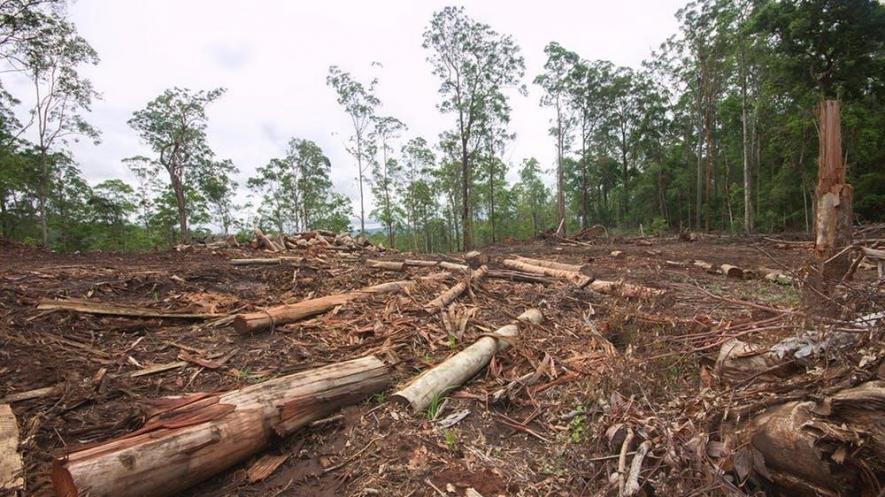Wood Harvesting to Release Billions of Tonnes of CO2 to Atmosphere Annually

Cutting a tree doesn’t only mean stopping the production of oxygen and absorption of carbon dioxide (CO₂), it also means new carbon dioxide is released into the atmosphere.
The CO₂ stored within the tree is released into the atmosphere slowly as it decays and faster when it is burnt. Therefore, deforestation is a primary CO₂ source. The greenhouse gas, in turn, contributes to global warming and the cascade of effects hereafter. Remember, CO₂ can remain in the atmosphere for thousands of years and thus continue global heating.
According to new research published in Nature, global wood harvesting will likely add 3.5-4.2 billion tonnes of CO₂ annually, equivalent to 10% of global emissions recently. Moreover, this level of emissions amounts to three times the emissions from aviation. Led by Liqing Peng, the research was conducted by the World Resource Institute (WRI).
The WRI research found that CO₂ emissions will increase in the coming decades due to wood harvesting because the global demand for wood will increase as more trees are felled for fuel, paper industry, furniture, and use in buildings. The global demand for wood is expected to increase up to 54% by 2050 compared to 2010 thus adding around 5.7 billion cubic metres of CO₂ in 2050 than 3.7 billion cubic metres in 2010.
These emissions remain undercounted or uncounted both in scientific papers and public policies as well, the researchers said. The emission from wood harvest is due to deforestation and other land use changes, including agricultural expansion.
Timothy Searchinger, a co-author of the research, technical director for agriculture, forestry and ecosystems of WRI and a research scholar at Princeton University, was quoted in a WRI press release: “Vast emissions from harvesting wood have mostly been ignored because of faulty carbon accounting. Global forests are growing and sequestering carbon due to climate change itself, and in the northern hemisphere, they are also growing back from massive deforestation in the previous two centuries.”
Searchinger added, “In these areas, most papers have treated the additional harvest of wood as having no climate effect, but if new wood harvests could be reduced, forests would grow even more overall, absorb even more carbon and reduce global warming more.”
The WRI researchers used a new model for global forest carbon known as CHARM (the global carbon harvest model). This model has been built upon a long-established approach where effects of wood harvest on atmospheric carbon over time are counted considering the carbon shift among the different storage pools. The storage pools can be vegetation, roots, wood products and landfills.
Actually, what is counted is the difference in the amount of carbon stored among the variety of storage pools due to harvest and the amount of carbon forests would have stored if not harvested and let its growth continue.
The study authors have predicted a hefty increase in forest cutting due to growing demand for various purposes. There will be around a 128% increase in demand for paper products and a 70% increase in furniture and other timber products. The demand for wood as fuel will likely increase by 22% by 2050.
The research suggests that mitigating wood harvest and reducing the dangers of carbon emissions lie in policy formulation where people reduce their use of wood for energy or other products. The research also suggests harvesting large trees in the tropics “in ways that kill fewer smaller trees and increase the growth rate of already existing plantation forests.”
In a research paper published in Science on May 18, researchers suggest that if removing intervention is minimised, under the present climatic condition, especially with the amount of CO₂ present in the atmosphere, the global forest would increase their biomass (above the ground) to 44 gigatonnes of carbon.
Citing the example of why emissions from wood harvest remain undercounted, Richard Waite, a co-author and a researcher at WRI, said in the press release: “One strange result of many papers today is that they consider the harvest of wood in the tropics to add emissions, but wood harvests in the temperate zone appear to have no effect on the climate.”
“That misleading result occurs basically because Europe, the US and China cleared more forests in the past. When they only report the net effect of new harvests against the regrowth of previously cleared forests, it looks like new harvests have no effect. Yet the fact that other trees are regrowing from past clearing does not make wood use inherently carbon neutral because harvesting wood in these countries still reduces the total amount of carbon in the forest.”
Get the latest reports & analysis with people's perspective on Protests, movements & deep analytical videos, discussions of the current affairs in your Telegram app. Subscribe to NewsClick's Telegram channel & get Real-Time updates on stories, as they get published on our website.
























